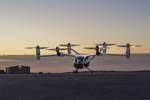Spirit AeroSystems to build new composite fuselage for HondaJet
A build-to-print composite fuselage and composite bonded frame are part of the work agreement with Honda Aircraft Company for its HondaJet 2600 concept.
Spirit AeroSystems (Wichita, Kan., U.S.) has announced an expansion of its manufacturing role for Honda Aircraft Co.’s (Greensboro, N.C., U.S.) new light jet that was first introduced at the 2021 NBAA-BACE as the HondaJet 2600 concept. The work includes an innovative build-to-print composite fuselage and a composite bonded frame. The new statement of work builds on Spirit’s technical expertise to implement affordable design and manufacturing efficiencies.
“This agreement expands our Regional and Business Jet portfolio and is a testament to our expertise in advanced materials and processes,” Alex Bellamy, vice president of regional and business jet programs at Spirit AeroSystems, says. “Our experienced and diverse teams worldwide continue demonstrating our capabilities in building next-generation aircraft.”
Spirit leverages decades of design and manufacturing expertise and its Tier 1 status as a provider of end-to-end aerostructure solutions for regional and business jets. It covers the full lifecycle from design through to aftermarket support. The company emphasizes its expertise in composite and metallic aerostructures for a wide range of business jet models, from wing structures to fuselage components and complex assemblies. Spirit also offers a range of cutting-edge solutions that are designed to improve performance, reduce costs and increase safety.
According to the company, the new light jet designed by Honda Aircraft Co. will surpass the performance, comfort and efficiency of typical light jets by providing a medium-sized jet experience. It is designed to be the first light jet capable of nonstop transcontinental flight across the U.S. with a quiet and spacious cabin suited for long-range travel and the ability to accommodate up to 11 occupants. The new light jet is expected to deliver up to 20% better fuel efficiency compared to typical light jets, and more than 40% better fuel efficiency than medium-sized jets during a typical mission.
Related Content
-
Combining multifunctional thermoplastic composites, additive manufacturing for next-gen airframe structures
The DOMMINIO project combines AFP with 3D printed gyroid cores, embedded SHM sensors and smart materials for induction-driven disassembly of parts at end of life.
-
Composites manufacturing for general aviation aircraft
General aviation, certified and experimental, has increasingly embraced composites over the decades, a path further driven by leveraged innovation in materials and processes and the evolving AAM market.
-
PEEK vs. PEKK vs. PAEK and continuous compression molding
Suppliers of thermoplastics and carbon fiber chime in regarding PEEK vs. PEKK, and now PAEK, as well as in-situ consolidation — the supply chain for thermoplastic tape composites continues to evolve.














